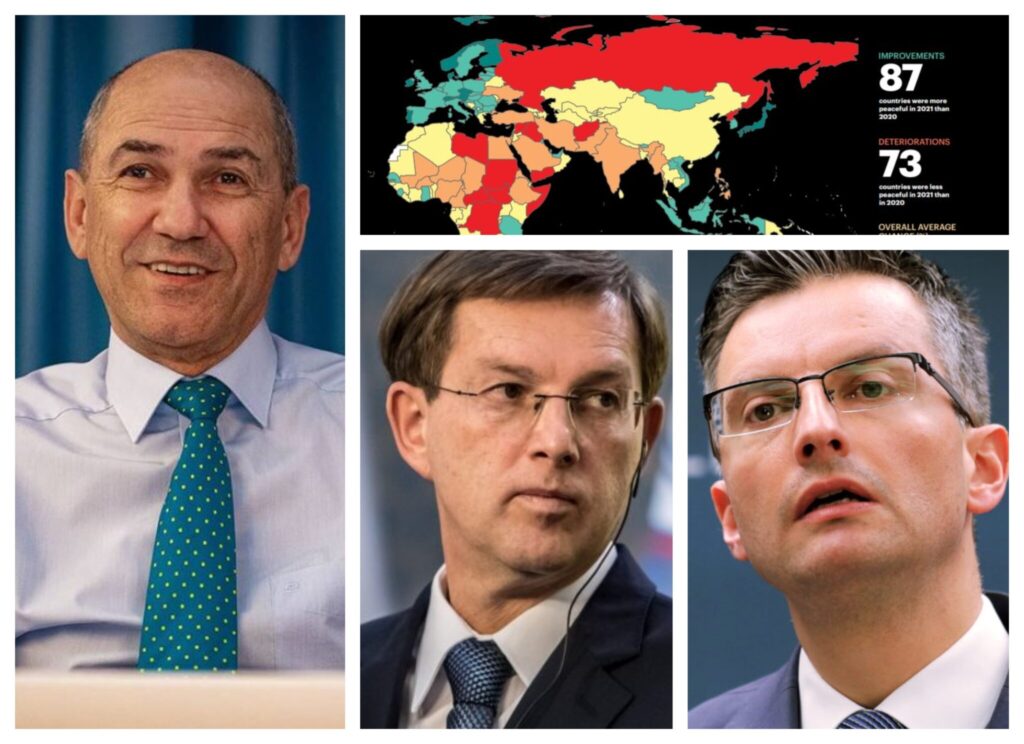The results of the report measuring the Global Peace Index for 2021 are now known. Although we can often hear how Slovenia is supposedly changing into a country with a dictatorship because of the current government, statistics prove once again that these are only malicious accusations that have nothing to do with reality. Namely, Slovenia ranks fifth among the most peaceful countries in the world, on the list of 136 countries.
The Global Peace Index covers 99.7 per cent of the world’s population, using 23 qualitative and quantitative indicators from highly respected sources, and measures the state of peace across three domains: the level of Societal Safety and Security, the extent of Ongoing Domestic and International Conflict, and the degree of Militarisation.
This year’s results show that the average level of global peacefulness deteriorated by 0.07 per cent. This is the ninth deterioration in peacefulness in the last thirteen years, with 87 countries improving and 73 recording deteriorations; however, the change in score is the second smallest in the history of the index. The 2021 GPI reveals a world in which the conflicts and crises that emerged in the past decade have begun to abate, only to be replaced with a new wave of tension and uncertainty as a result of the COVID-19 pandemic and rising tensions between many of the major powers, the description of the 2021 report reads.
Only Portugal, Denmark, New Zealand, and Iceland ahead of Slovenia
Iceland remains the most peaceful country in the world, a position it has held since 2008. It is joined at the top of the index by New Zealand, Denmark, Portugal, and our home country, Slovenia. Our neighbouring Austria is in sixth place, followed by Switzerland, Ireland, Czech, and Canada. Afghanistan is the least peaceful country in the world for the fourth consecutive year, followed by Yemen, Syria, South Sudan, and Iraq. All of these countries, except Yemen, have been ranked amongst the five least peaceful nations since at least 2015, with Afghanistan having been ranked amongst the three least peaceful nations since 2010.
Majority of the most peaceful countries in Europe
Eight of the ten countries at the top of the Global Peace Index are located in Europe. This is the most European countries to be ranked in the top ten in the history of the index. Singapore fell out of the top ten, replaced by Ireland ,which improved by three places. Only three of the nine regions in the world became more peaceful over the past year. The largest improvement occurred in the Middle East and North Africa (MENA), followed by Europe and South Asia. However, MENA still remains the least peaceful region in the world. An improvement in the level of Ongoing Conflict in MENA was the biggest driver of increased peacefulness, with every indicator on the domain recording an improvement. In Europe, the improvement in peacefulness was driven by improvements in internal safety and security, including improvements in terrorism impact, violent demonstrations, and violent crime.
The largest regional deterioration occurred in North America, which deteriorated across all three domains of the Global Peace Index. The primary driver of this fall in peacefulness was a deterioration in the Safety and Security domain, especially in the United States, where growing civil unrest led to increased perceptions of criminality and political instability and more violent demonstrations.
Despite the high fear of violence across the world, most people feel that the world is getting safer. Nearly 75 per cent of people globally feel as safe or safer today than they did five years ago. The region that fared the worst was South America, where over 50 per cent of those surveyed felt less safe than five years ago.
The country that recorded the highest fear of violence was Brazil, where nearly 83 per cent of Brazilians were very worried about being a victim of violent crime.
Slovenia ranked the highest during the time of Janez Janša’s government
If we take a closer look at the data for the past two governments, we can see that during the government of Miro Cerar (September 2014 – September 2018), the data of the Global Peace Index were as follows: 2014 – 10th place, 2015 – 10th place, 2016 – 8th place, 2017 – 7th place, and 2018 – 7th place. During the time of the Marjan Šarec government (September 2018 – March 2020), the data were as follows: 2019 – 6th place, 2020 – 10th place.
As we can see, Slovenia achieved the best result during the time when it is being led by the government of Janez Janša. This only further proves how the left is constantly manipulating the servicing of data, which has little to do with reality. Then this data continues to be exported abroad. Even if you repeat the same lie enough times, it still does not become the truth. In any case, the result is more than clear and only proves that it is more than appropriate for Slovenia to hold the Presidency of the European Council.
Nina Žoher


